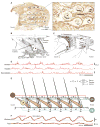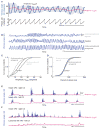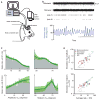The Brainstem Oscillator for Whisking and the Case for Breathing as the Master Clock for Orofacial Motor Actions
- PMID: 25876629
- PMCID: PMC4924579
- DOI: 10.1101/sqb.2014.79.024794
The Brainstem Oscillator for Whisking and the Case for Breathing as the Master Clock for Orofacial Motor Actions
Abstract
Whisking and sniffing are predominant aspects of exploratory behavior in rodents. We review evidence that these motor rhythms are coordinated by the respiratory patterning circuitry in the ventral medulla. A recently described region in the intermediate reticular zone of the medulla functions as an autonomous whisking oscillator, whose neuronal output is reset upon each breath by input from the pre-Bötzinger complex. Based on similarities between this neuronal circuit architecture and that of other orofacial behaviors, we propose that the pre-Bötzinger complex, which projects broadly to premotor regions throughout the intermediate reticular zone of the medulla, functions as a master clock to coordinate multiple orofacial actions involved in exploratory and ingestive behaviors. We then extend the analysis of whisking to the relatively slow control of the midpoint of the whisk. We conjecture, in a manner consistent with breathing as the "master clock" for all orofacial behaviors, that slow control optimizes the position of sensors whereas the breathing rhythm provides a means to perceptually bind the inputs from different orofacial modalities.
Copyright © 2014 Cold Spring Harbor Laboratory Press; all rights reserved.
Figures








Similar articles
-
Circuits in the rodent brainstem that control whisking in concert with other orofacial motor actions.Neuroscience. 2018 Jan 1;368:152-170. doi: 10.1016/j.neuroscience.2017.08.034. Epub 2017 Aug 23. Neuroscience. 2018. PMID: 28843993 Free PMC article. Review.
-
Hierarchy of orofacial rhythms revealed through whisking and breathing.Nature. 2013 May 9;497(7448):205-10. doi: 10.1038/nature12076. Epub 2013 Apr 28. Nature. 2013. PMID: 23624373 Free PMC article.
-
Inhibition, Not Excitation, Drives Rhythmic Whisking.Neuron. 2016 Apr 20;90(2):374-87. doi: 10.1016/j.neuron.2016.03.007. Epub 2016 Mar 31. Neuron. 2016. PMID: 27041498 Free PMC article.
-
Circuits in the Ventral Medulla That Phase-Lock Motoneurons for Coordinated Sniffing and Whisking.Neural Plast. 2016;2016:7493048. doi: 10.1155/2016/7493048. Epub 2016 May 18. Neural Plast. 2016. PMID: 27293905 Free PMC article. Review.
-
Theory of hierarchically organized neuronal oscillator dynamics that mediate rodent rhythmic whisking.Neuron. 2022 Nov 16;110(22):3833-3851.e22. doi: 10.1016/j.neuron.2022.08.020. Epub 2022 Sep 15. Neuron. 2022. PMID: 36113472 Free PMC article.
Cited by
-
Functional brain stem circuits for control of nose motion.J Neurophysiol. 2019 Jan 1;121(1):205-217. doi: 10.1152/jn.00608.2018. Epub 2018 Nov 21. J Neurophysiol. 2019. PMID: 30461370 Free PMC article.
-
Coding of whisker motion across the mouse face.Elife. 2019 Feb 28;8:e41535. doi: 10.7554/eLife.41535. Elife. 2019. PMID: 30816844 Free PMC article.
-
Circuits in the rodent brainstem that control whisking in concert with other orofacial motor actions.Neuroscience. 2018 Jan 1;368:152-170. doi: 10.1016/j.neuroscience.2017.08.034. Epub 2017 Aug 23. Neuroscience. 2018. PMID: 28843993 Free PMC article. Review.
-
Feedforward motor information enhances somatosensory responses and sharpens angular tuning of rat S1 barrel cortex neurons.Elife. 2017 Jan 6;6:e21843. doi: 10.7554/eLife.21843. Elife. 2017. PMID: 28059699 Free PMC article.
-
Coordination of Orofacial Motor Actions into Exploratory Behavior by Rat.Curr Biol. 2017 Mar 6;27(5):688-696. doi: 10.1016/j.cub.2017.01.013. Epub 2017 Feb 16. Curr Biol. 2017. PMID: 28216320 Free PMC article.
References
-
- Berg RW, Kleinfeld D. Rhythmic whisking by rat: Retraction as well as protraction of the vibrissae is under active muscular control. Journal of Neurophysiology. 2003;89:104–117. - PubMed
-
- Bieger D, Hopkins DA. Viscerotopic representation of the upper alimentary tract in the medulla oblongata in the rat: The nucleus ambiguus. Journal of Comparative Neurology. 1987;262:546–562. - PubMed
-
- Bouvier J, Thoby-Brisson M, NR, Dubreuil V, Ericson J, Champagnat J, Pierani A, AC, Fortin G. Hindbrain interneurons and axon guidance signaling critical for breathing. Nature Neuroscience. 2010;13:1066–1074. - PubMed
-
- Brecht M, Krauss A, Muhammad S, Sinai-Esfahani L, Bellanca S, Margrie TW. Organization of rat vibrissa motor cortex and adjacent areas according to cytoarchitectonics, microstimulation, and intracellular stimulation of identified cells. Jounal of Comparative Neurology. 2004;479:360–373. - PubMed
Publication types
MeSH terms
Grants and funding
LinkOut - more resources
Full Text Sources
Other Literature Sources
